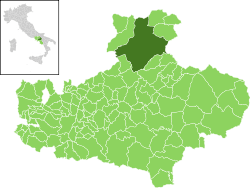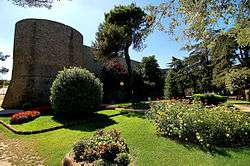Ariano Irpino
| Ariano Irpino | ||
|---|---|---|
| Comune | ||
| Città di Ariano Irpino | ||
|
Panorama of Ariano Irpino | ||
| ||
 Ariano Irpino within the Province of Avellino | ||
 Ariano Irpino Location of Ariano Irpino in Italy | ||
| Coordinates: 41°9′0″N 15°5′3″E / 41.15000°N 15.08417°ECoordinates: 41°9′0″N 15°5′3″E / 41.15000°N 15.08417°E | ||
| Country | Italy | |
| Region | Campania | |
| Province / Metropolitan city | Avellino (AV) | |
| Frazioni | Ariano Scalo, Camporeale, Cardito, Difesa Grande, Frolice, Manna, Martiri, Orneta, San Liberatore, San Nicola Trignano, San Pietro, Santa Barbara, Tesoro, Valleluogo | |
| Area | ||
| • Total | 185.52 km2 (71.63 sq mi) | |
| Elevation | 817 m (2,680 ft) | |
| Population (2011)[1] | ||
| • Total | 22,517 | |
| • Density | 120/km2 (310/sq mi) | |
| Demonym(s) | Arianesi | |
| Time zone | CET (UTC+1) | |
| • Summer (DST) | CEST (UTC+2) | |
| Postal code | 83031 | |
| Dialing code | 0825 | |
| Patron saint | Otto Frangipane | |
| Saint day | 23 March | |
| Website | Official website | |
Ariano Irpino (formerly Ariano di Puglia or simply Ariano) is an Italian town and municipality in the province of Avellino, in Campania region. With a population of 22,517 (2011),[1] it is the second town of the province after Avellino.
Geography
Overview
At an elevation of 817 metres (2,680 ft) above sea level, Ariano Irpino is practically centred between the Adriatic Sea and the Tyrrhenian Sea. It is 34 km east of Benevento and 62 km west of Foggia.
Formerly called just Ariano, it was built on three hills, and for that reason it is also known as Città del Tricolle (City of the Three Hills). From 1868 to 1930, when it became part of Campania, it was known as Ariano di Puglia. Irpinia is the name given to the area of the Apennine Mountains around Avellino. The name derives from the Oscan word hirpus, meaning wolf.
Ariano lies in the centre of a fertile district, but has no buildings of importance, as it has often been devastated by earthquakes. A considerable part of the population still dwelled in caves until 1911. It has been supposed to occupy the site of Aequum Tuticum, an ancient Samnite town which became a post-station on the Via Traiana in Roman times; but this should probably be sought at S. Eleuterio, 82 kilometres (51 mi) north. It was a military position of some importance in the Middle Ages. About 20 kilometres (12 mi) south-southeast is the Sorgente Mefita, identical with the pools of Ampsanctus.
Administration
The municipality borders with Apice (BN), Castelfranco in Miscano (BN), Flumeri, Greci, Grottaminarda, Melito Irpino, Montecalvo Irpino, Monteleone di Puglia (FG), Savignano Irpino, Villanova del Battista and Zungoli.[2]
It counts the hamlets (frazioni) of Ariano Scalo, Camporeale, Cardito, Difesa Grande, Frolice, Manna, Martiri, Orneta, San Liberatore, San Nicola Trignano, San Pietro, Santa Barbara, Tesoro and Valleluogo.
History
The city's origins are very ancient. Archeological evidence points to its continuous settlement from the Neolithic (c. 7th millennium BC) to around 900 BC. The foundation of the Italian, Greek, and Roman city of Aequum Tuticum was generally credited to the Homeric hero Diomedes, although others ascribed it to the Hirpini Samnites. Under the Romans, Aequum Tuticum was the crossroads of the Via Traiana and Via Herculeia highways. The town declined following the onset of the barbarian invasions.

As a result of this, the three hills started to be inhabited, a high and easily defendable place, and it is here that Ariano was born, a fortified city in a strategic position; today its ancient and formidable defensive walls are still recognizable and are part of the city. In a secure place away from the invasions of the Goths and Byzantines, Ariano is a fortified city of the Lombards. Around 1000 the Castle was built to defend the city against the Byzantines which, although ruined, still proudly stands in the Villa Comunale city park.
Successively conquered by the Normans, in 1140 it was the place where were promulgated, by Roger II of Sicily, the Assizes of Ariano, the then-new constitution of the Kingdom of Sicily. This legal corpus will be adopted almost integrally and with a few variations into the Constitutions of Melfi of the Emperor Frederick II. In the same year it is coined the ducat, a coin that will last for seven centuries, until 1860.
In 1255, Manfred, son of Frederick Hohenstaufen, besieged the city, which resisted strongly thanks to its walls and the combative nature of the inhabitants. During the siege, a group of soldiers from Lucera pretended to be disserters of Manfred's army, and were welcomed into the city. During the night, they revealed their double face, sacking and destroying the city with the fire and killing all the inhabitants. There's still a road in memory of that tragic event, called La Carnale (The Carnage).
More than ten years later, in 1266, Charles I of Anjou rebuilt the city and gave it two thorns of the crown of Christ, still conserved in a reliquary into the city's Romanesque cathedral. All these happenings are reproduced every year in the Rievocazione Storica del Dono delle Sante Spine (Historical Reinvocation of the Gift of the Sacred Thorns) and in the reproduction of the Incendio del Campanile (Belltower Burning), a pyrotechnic event that lights the main square of the city and the side of the cathedral.
After the Capetian House of Anjou lost control of Sicily to Peter III of Aragon in the War of the Sicilian Vespers, the city passed to the Provenzale dei Desambramo family from 1294 to 1413; and then in the hands of the Carafa family and the House of Gonzaga. Still today are there in the city buildings that were of the Spanish families which governed at that time. On 2 August 1545 the city rebelled against the feudal regime and became a Città Regia (city-state) dependent on the Viceroy of the Kingdom of Sicily.
Demographics



Culture
Majolica
Ariano is known for the production of majolica, a tin-glazed pottery.[3] The first examples date from the 13th century under the Moorish influence of the Spanish, but Ariano Irpino's majolica became more refined around the 18th century, when the first amphoras and pitchers appear, often simple in the shape, but thinly elaborated. Today's production is bigger than ever, including flask, busts, cups, plates, figures, amphoras. All pieces are splendidly decorated by the craftsmen of Ariano, and often have a fine and elaborate shape.
In popular culture
The fictitious crime family depicted in the American television series The Sopranos trace their origins to this city. Precisely the capostipites of the Soprano family (Corrado Soprano Sr. and Mariangela D'Agostino) emigrated from Ariano to New Jersey in 1911 (when the city was still called Ariano di Puglia); and also some other characters state that they are from Ariano. Specifically Paulie Gualtieri states his grandfather was from Ariano Irpino in the episode Commendatori. The likely reason for this connection is that series creator David Chase traces his mother's family origins to Ariano.
Personalities
- Hieronymus Angerianus (1470-1535), humanist
- Diomede Carafa (1492-1560), bishop
- Ottone Frangipane (1040-1127), saint
- Luca Morelli (b. 1987), motorcycle racer
See also
References
- 1 2 (Italian) Source: Istat 2011
- ↑ 41091 Ariano Irpino on OpenStreetMap
- ↑ (Italian) The "Maiolica Arianese"
External links
| Wikimedia Commons has media related to Ariano Irpino. |
- (Italian) Comune di Ariano
- (Italian) Città di Ariano

